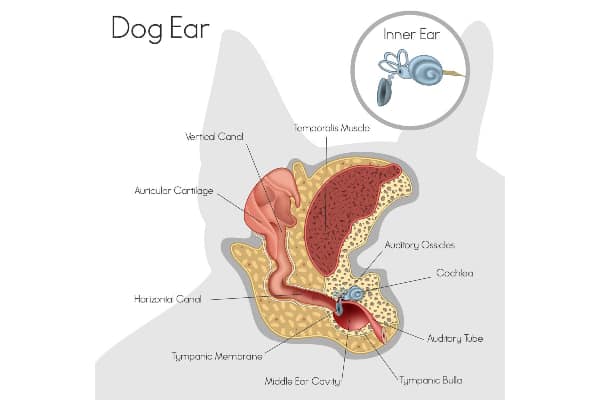Dog Starts Staggering and Walking Funny
Realizing "My dog is wobbly and off balance" can be disconcerting for even the most seasoned dog parent. Integrative veterinarian, Dr. Julie Buzby, dives deep into the heart of your dog's nervous system to explain the "why" behind the loss of balance and seven conditions that could be the culprit.

What should you do if your dog is staggering around like he or she spent a bit too much time on a merry-go-round? The answer—take a calming breath, then call your vet. Let him or her know, "My dog is wobbly and off balance."
I understand how unnerving it can be to watch your beloved dog lose balance and even stumble around. I've witnessed these signs in my own canine patients, and I've felt my clients' concerns along with them.
That's why I want to share seven reasons a dog may be wobbly and off balance. But first, let's dive into some nervous system anatomy so we can better understand what's going on with a wobbly dog.
Ataxia in dogs: an uncoordinated gait
When I see a dog who is wobbly and off balance, I think of the word ataxia. This is the medical term for an uncoordinated gait. Ataxia is classified based on which structure in the nervous system is affected—the cerebellum, the spinal cord, or the vestibular system.
Cerebellar ataxia in dogs
The cerebellum is the small part of the brain that sort of looks like a walnut. It sits just behind the cerebrum (large portion of the brain responsible for learning and memory).
The cerebellum plays a role in balance, posture, and coordination of voluntary movements. Thus, damage to the cerebellum impairs these functions.
Signs of cerebellar ataxia in dogs may include:
- Exaggerated high stepping gait.
- Tremors that occur when trying to initiate voluntary movement.
- Wide based stance in the rear legs.
- Head and body tremors.
Spinal ataxia (proprioceptive ataxia) in dogs
The spinal cord transmits information between the body and the brain. One of its many uses is proprioception—the ability of the body to sense and change how the limbs are positioned. Sensory receptors in the limbs send information up the nerves to the spinal cord. One of two things happen with this information.
One option is that the signal causes an immediate reaction, known as a reflex. This is what occurs when you touch a hot stove and rapidly jerk your hand away. The body acts before you are even conscious of what happened.
The other option is that the information continues up the spinal cord to the brain. The brainstem, cerebellum, and cerebrum process that information then send signals back to the limbs via the spinal cord.
Testing conscious proprioception in dogs
Vets may evaluate part of this system by flipping a dog's foot over. Now the top of the foot is against the floor. In a normal dog, the sensory receptors send a message up the nerve to the spinal cord that says, "My foot is upside down."
The signal goes up the spinal cord, through the brainstem and to the cerebrum. The cerebrum says, "Hmm…that isn't right. I need to fix the position of the foot." So a signal is sent back down to the foot to tell the dog's muscles, "Flip the foot back so the paw pad is against the ground."
You can watch me perform this test in this video, Knuckling in Dogs: How to Test a Dog for Conscious Proprioception.

When the spinal cord is damaged, signals can't get to or from the brain. The portion of the spinal cord in front of the damaged area will function normally. However, communication is slowed or cut off to the body parts behind the damaged area. This means the dog will not flip the foot over or will do so slowly.
Signs of spinal cord problems
Dogs who have spinal ataxia may also:
- Sway or wobble back and forth.
- Stand with the limbs positioned abnormally (i.e. crossed or splayed out).
- Swing the limbs out widely or cross them when walking.
- Be unable to move the affected limbs.
Vestibular ataxia in dogs
The vestibular system is made up of the inner ear, vestibulocochlear nerve, brainstem, and cerebellum. The inner ear is located within the skull and contains fluid-filled semi-circular loops. These loops run in different directions such as horizontally and vertically, almost like the tracks of a rollercoaster.
Hair cells inside the ducts are displaced when the fluid moves relative to the body's position (e.g., standing up or lying down). This creates a signal that travels through the vestibular branch of the vestibulocochlear nerve to the brainstem.

Nerve signals may stop at the brainstem or proceed to the cerebellum. The brainstem controls things that dogs do without being consciously aware of them, in this case stance and posture. The cerebellum, as discussed above, regulates voluntary muscle movements to help a dog balance.
Signs of vestibular syndrome in dogs
Damage to any of these components will cause a dizzy dog who may:
- Appear wobbly and off balance as though drunk.
- Drool excessively.
- Stumble when walking.
- Exhibit rapid involuntary eye movements (nystagmus).
- Have a head tilt.
- Repeatedly circle in place, which looks like walking in circles.

Why is my dog wobbly and off balance? 7 common culprits
Now that you understand the different types of ataxia, we can start to address the seven reasons why a dog is wobbly and off balance.
1. Ear infections in dogs
Before we start talking about ear infections in dogs, we need to review some ear anatomy.
The external ear is the portion that you would see if you peered into your dog's ear. It is L shaped, and ends at the eardrum (i.e. tympanic membrane). The middle ear is an open space immediately behind the ear drum. Just above this space are the the small bony structures that make up the inner ear.

Remember how we talked about the role of the inner ear and vestibulocochlear nerve in the vestibular system? It makes sense then that infection or inflammation in the middle or inner ear could keep those structures from functioning correctly. The end result? A dog who is wobbly and off balance.
In this case, we are talking about vestibular ataxia caused by peripheral vestibular disease. The term peripheral denotes the problem lies with the inner ear and/or nerve. This is in contrast to central vestibular disease where the brainstem and brain are affected (more on that later).
Dogs with peripheral vestibular disease usually have horizontal nystagmus. This means their eyes move rapidly from side to side. They are usually awake, aware, and acting like themselves. We refer to this as having normal mentation.
If present, head tilt and circling are usually towards the abnormal ear. For example, if the left ear is affected, the head tilt and circling are to the left. You may also notice any of the other signs listed above for vestibular syndrome.
Causes of ear infections in dogs
Otitis interna (inner ear infections) and otitis media (middle ear infections) can be caused by:
- Bacteria such as Staphylococcus, Streptococcus, Proteus, Pseudomonas, Enterococcus spp., and E. coli.
- Fungi
- Foreign bodies
- Cancer
- Bloodborne spread of infections from other locations
- Trauma
Sometimes, external ear infections can extend into the middle and inner ear. In those cases, affected dogs will also show signs of external ear infections. These include debris in the ear canal, head shaking, or ear scratching. Other times, the external ear canal will be completely normal.

2. Brain conditions in dogs
A variety of conditions can affect the brain or brainstem, causing central vestibular disease. Affected dogs tend to have vertical nystagmus (eyes moving up and down) rather than horizontal.
In addition to the other symptoms of vestibular syndrome listed previously, they may have impaired or dull mentation. This means they are slow to process information or respond to stimuli, are unaware of their surroundings or are not acting like themselves. Seizures may also occur.
Infection, inflammation, or brain tumors (tumors of the brain or brainstem) are the most common reasons for a dog to develop central vestibular syndrome signs. Infections may be caused by bacteria, fungi, viruses, or protozoa. Many of these same causes can also affect the cerebellum, causing cerebellar ataxia.
3. Old dog vestibular disease
Sometimes a dog will be wobbly and off balance and show other vestibular signs that are not related to hypothyroidism in dogs, tick-borne diseases in dogs, or any of the other causes discussed above. We call this idiopathic vestibular disease. The other name for it is old dog vestibular disease because it happens more commonly in older dogs.
In fact, it also happens to be the most common cause of vestibular disease overall. The good news is that signs often resolve over a period of a few days with supportive therapy. So if there is a "good" type of vestibular syndrome, it is this one.
To learn more about old dog vestibular disease, please refer to my article, Old Dog Vestibular Disease: A True Story About Doggy Vertigo. Also, if your dog has been diagnosed with any of the causes of vestibular disease, you might find these 10 Tips and Exercises for Dogs with Vestibular Disease helpful.
4. Stroke
While strokes are less common in dogs than in humans, they do still happen occasionally. Strokes occur when blood flow to the brain is disrupted due bleeding or an obstruction in a vessel. Without the oxygen, glucose (fuel for the brain), and other blood components, the brain doesn't function correctly. As a result, a dog may be wobbly and disoriented or show other vestibular syndrome signs.

You can read my article, Dog Stroke Symptoms & Treatments in Senior Dogs to find out more.
5. Spinal cord conditions
Anything that damaged or disrupts the spinal cord can cause spinal ataxia. This is the case in IVDD (intervertebral disc disease) in dogs. In this condition, disc material leaves its normal position between two vertebrae (bones in the spine) and starts to press on the spinal cord.
When the spinal cord is compressed, nerve signals have trouble moving past the affected area. In some cases, a vet may recommend IVDD surgery for dogs. Other times, non-surgical IVDD recovery in dogs is possible.
Spinal stroke in dogs is another condition that may cause a dog to be wobbly and off balance. The other name for this condition, fibrocartilaginous embolism (FCE), gives a clue about how it occurs.
A piece of intervertebral disc material (a fibrocartilaginous substance) breaks off and blocks one of the blood vessels that nourishes the spinal cord. When blood supply is obstructed (i.e. an embolism occurs), the portion of the spinal cord supplied by that vessel is damaged.
6. Trauma
Some ataxic or disoriented dogs have external injuries that might point to a known or suspected traumatic event as the cause of the signs. The brain and spinal cord can be damaged by :
- Motor vehicle accidents.
- Falls from a great height.
- Crush injuries.
- Gunshot wounds, bites, or other penetrating injury.
- Blows from an object, animal, or person.
- Violent shaking.

Head trauma causes damage to the neurons and bleeding and swelling in the brain. If there is swelling in other parts of the body, it isn't as big of a deal. For example, a leg has space to expand outward when it swells. Not so much with the brain since the skull is a fixed size.
As the brain swells and blood builds up around the brain, the pressure in the skull (intracranial pressure) increases, compressing the brain tissue. This makes it harder to get the blood through the vessels in the brain.
Without the blood supplying needed nutrients and oxygen, brain function declines and the dog may become depressed or disoriented. Cerebellar and/or vestibular ataxia will also occur if either of those systems are damaged.
Spinal cord trauma will cause spinal ataxia since the neurons are damaged by the initial injury and the body's response to the injury. In severe cases, the dog may even be paralyzed.
7. Toxins
Lastly, a variety of toxic substances can cause a dog to be wobbly and off balance. They may also cause other neurologic signs like seizures or tremors, as well as heart, lung, kidney, liver, or gastrointestinal signs.

Toxins to suspect include:
- Metaldehyde (a component of slug bait).
- Mycotoxins (toxic substances produced by fungi found on moldy food or trash).
- Cannabis (marijuana).
- Permethrin (insecticide found in powders, sprays, bait stations, and some flea treatments).
- Ivermectin (anti-parasitic drug that can be toxic at higher doses, but is typically safe at the dose used as a preventative for heartworm disease in dogs).
- High doses of drugs such as aminoglycoside antibiotics and metronidazole.
Other toxins not on this list are also capable of causing neurologic signs and some intoxications may be fatal. Anytime you suspect your dog may have ingested a toxic substance, immediately contact your veterinarian or the ASPCA Animal Poison Control Center. (Please note, there is a consultation fee charged for the ASPCA's services.)
Enlist the help of your vet
If you notice your dog is wobbly and off balance, call your vet right away. You may have a suspicion about which of these seven conditions is the culprit. However, your vet is the best person to help reach a diagnosis and formulate a treatment plan.
The outlook for these diseases can vary, but starting appropriate treatment right away typically can give your canine companion the best chance at recovery.

Has your dog ever been wobbly and off balance?
Feel free to share your dog's story. We can all learn from each other.
Source: https://toegrips.com/my-dog-is-wobbly-and-off-balance/
0 Response to "Dog Starts Staggering and Walking Funny"
Post a Comment